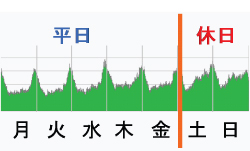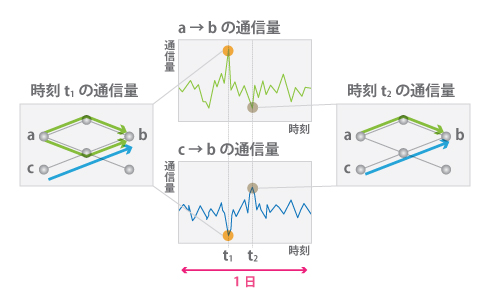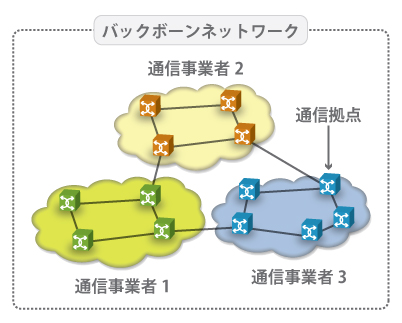Research Overview
(2) Network Control

Research Topics
Network Control
Internet Traffic Prediction Algorithm
The amount of traffic passing through networks has been increasing explosively. In order to accommodate the large amount of traffic expected in an efficient way, load balancing is a promising technology, where the appropriate communication routes are selected. From the viewpoint of power consumption reduction in networks, [[MEANING UNCLEAR it will be an effective way to shut down the power supply of a part of or the whole of each network equipment with low-duty during some time interval, rather than the method with re-routing communication traffic.]]
If routing control is to satisfy various kinds of requirements, relatively rapid traffic prediction techniques (within a few minutes to an hour), are essential, since network control must allocate sufficient communication bandwidth with low control latency. Furthermore, it is also important for the control to consider the daily or weekly cyclic characteristics of Internet traffic patterns created the periodicity of Internet user number and [[MEANING UNCLEAR the nearly steady tendency]] of user’s daily Internet access (see Fig. 1).
The main purpose of the research is to predict the amount of Internet traffic by referencing these cyclic characteristics and short period Internet traffic fluctuations as well.
Adaptive Network Control based on Traffic Prediction
The amount of traffic passing through networks is increasing in an explosive way due to the emergence of streaming services such as Japanese “Nico-Nico moving image” and YouTube. It is expected that the traffic volume will keep increasing in the future due to emerging applications such as super high-resolution moving image delivery and 3DTV services. When we investigate the traffic patterns in terms of time, [[MEANING UNCLEAR there exist two types of time zones with a large amount of traffic and a small amount of traffic]] (see Fig. 1). Moreover, each geographical location exhibits its own traffic fluctuation depending on its office and residential areas (see Fig. 2).
In photonic networks, it is necessary to configure communication paths (optical paths). As shown in Figures 1 and 2, the optimal configuration of optical paths (routes and the number of paths) depends on the time zones, since the traffic volume differs with time (Fig. 3). Hence, we have developed network control algorithms for efficient network utilization, where the traffic route and the number of electrical/optical paths and the capacities are [[SEEMS TO CONTRADICT THE ABOVE ? WHAT HAPPENDED TO TIME FACTOR & PERIODICITY?? adaptively controlled depending on the traffic fluctuation.]]

Figure1 Cyclic Characteristics of Traffic
Router Systems using Traffic Control, and Ultra-Low Power Consumption Network
Power consumption in the ICT area is increasing every year, and hence, a reduction in power consumption is required so that sustainable advances can be attained. In order to deal with the future growth of network traffic demand, more packets will be processed at router equipment, which leads to an explosive increase in the power consumption of core and metro networks. Reducing this power consumption is one of the crucial goal.
Current router systems consume almost constant power regardless of packet processing volume. This is because current routers are not designed to adapt its performance to the number of input packets. Our research is directed towards reducing power consumption significantly by adjusting router processing performance to match the volume of packets.
Ultra-Large Scale Network Control
World-wide communication networks consists of several large-scale backbone networks owned by different service providers that are interconnected (Fig. 4). In the future, transparent optical reach will be enhanced and hence the virtual optical network part will become larger and accommodate more applications such as UHDTV (Ultra High Definition TV) services. To cope with this situation, highly-efficient overall network control is a crucial research issue.
For security, service providers do not want to disclose details of their networks; network configurations, the number of fibers installed, and information on their network congestion. Hence, it is very difficult to design and configure the optimal communication route. Furthermore, for emerging real time applications that require large capacity, it is necessary to configure the optimal route in a short time.
Our research objective is to develop algorithms to control ultra-large scale networks in an efficient manner.
Optimal Traffic Control for Core/Edge Systems, and the Implementation
Under Construction
Traffic Control (Traffic Engineering) across Plural Layers (Optical/Electrical)
Emerging broadband applications include Grid Computing and TV conference systems, etc. Such applications inherently demand bandwidth (communication speed) guarantees due to their real-time characteristics. In the international standards arena, network control based on ASON (Automatic Switched Optical Network) and GMPLS (Generalized Multi-Protocol Label Switching) continues to progress. These newly applications and technologies together make it possible for service providers to provide new services with dynamic bandwidth allocation. Specifically in the United States, service providers such as AT&T and Verizon have started providing dynamic leased line (electrical path) services. By controlling communication paths in a dynamic way, it is possible to utilize limited network resources more efficiently.
Our laboratory has been developing various types of traffic control technologies such as wavelength path and waveband path allocation and efficient electrical path accommodation algorithms, which should provide the more efficient use of network resources by adaptively configuring optical/electrical paths in a hierarchical optical/electrical network.
Next Generation Communication Protocols
In response to the rapid penetration of broadband access networks such as ADSL (Asynchronous Digital Subscriber Line) and FTTH (Fiber To The Home), the amount of traffic passing through the networks has been increasing explosively. This trend is expected to continue for a long period due to the emergence and introduction of IPTV (Internet Protocol Television) and HDTV (High Definition Television). Hence the next generation backbone network must offer ultra-high capacity and more efficient network operation by dynamically controlling communication paths.
Actually, it is possible to realize a high-capacity network by introducing “waveband paths” which logically aggregate multiple wavelength paths (see Fig. 5). The dynamic control can be realized by GMPLS (Generalized Multi-Protocol Label Switching) which is a protocol handling various types of paths in an integrated manner. However, GMPLS standardization remains at the stage of the wavelength path, and waveband paths remain a future standardization issue.
Our research objective is to develop GMPLS extensions that handle waveband paths with diverse types of logical structures, and the various communication protocols required for new networks.



